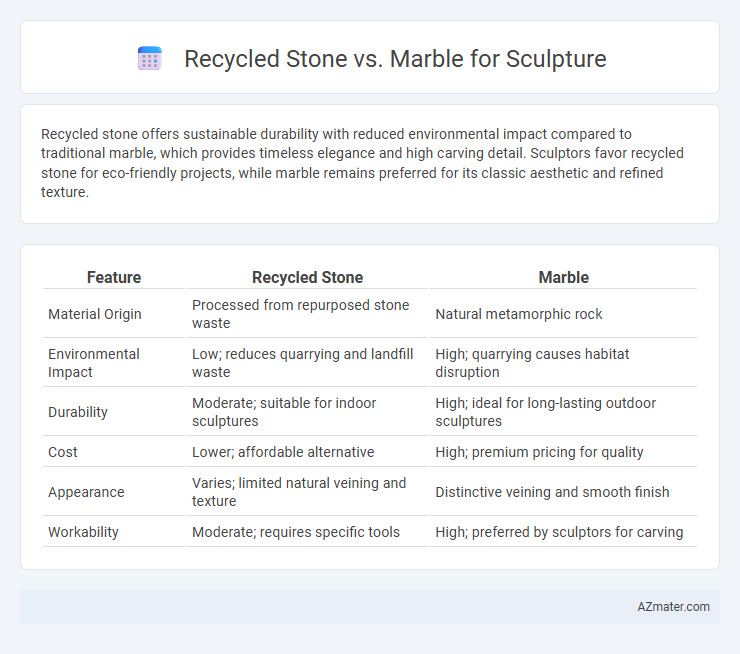Recycled stone offers sustainable durability with reduced environmental impact compared to traditional marble, which provides timeless elegance and high carving detail. Sculptors favor recycled stone for eco-friendly projects, while marble remains preferred for its classic aesthetic and refined texture.
Table of Comparison
| Feature | Recycled Stone | Marble |
|---|---|---|
| Material Origin | Processed from repurposed stone waste | Natural metamorphic rock |
| Environmental Impact | Low; reduces quarrying and landfill waste | High; quarrying causes habitat disruption |
| Durability | Moderate; suitable for indoor sculptures | High; ideal for long-lasting outdoor sculptures |
| Cost | Lower; affordable alternative | High; premium pricing for quality |
| Appearance | Varies; limited natural veining and texture | Distinctive veining and smooth finish |
| Workability | Moderate; requires specific tools | High; preferred by sculptors for carving |
Introduction to Sculpture Materials
Recycled stone offers an eco-friendly alternative to traditional marble in sculpture, reducing environmental impact by repurposing existing materials. Marble remains a preferred choice due to its durability, fine grain, and classic aesthetic that allow for detailed carving and a smooth finish. Selecting between recycled stone and marble depends on factors like sustainability goals, desired texture, and budget constraints in sculpture projects.
What is Recycled Stone?
Recycled stone is crafted from repurposed natural stone fragments and industrial byproducts, offering an eco-friendly alternative to traditional marble in sculpture. It combines crushed stone, concrete, and resin to create durable, cost-effective, and sustainable material with similar aesthetic qualities to marble. Sculptors favor recycled stone for its reduced environmental impact and versatility in texture and color, making it a popular choice in contemporary art and architecture.
Understanding Marble as a Traditional Medium
Marble remains a favored material in sculpture due to its fine grain, durability, and ability to achieve detailed, smooth finishes that highlight artistic precision. Recycled stone, while environmentally sustainable, often lacks the consistency and workability of traditional marble, which has been prized since classical antiquity for its aesthetic qualities. Understanding marble's unique translucency and strength is essential for appreciating why sculptors continue to choose it despite the growth of alternative recycled materials.
Comparing Physical Properties: Strength and Texture
Recycled stone offers notable strength comparable to natural marble, often exhibiting enhanced durability due to the binding resins used in its composition. Marble features a smooth, fine-grained texture prized for intricate sculptural details, while recycled stone may present slight textural variability, contributing to a unique aesthetic. The choice between recycled stone and marble depends on desired strength characteristics and texture preferences for the sculpture's visual and tactile qualities.
Sustainability and Environmental Impact
Recycled stone offers significant sustainability advantages over marble by reducing quarrying waste and minimizing environmental degradation associated with stone extraction. Marble quarrying generates substantial carbon emissions and habitat disruption, while recycled stone repurposes existing material, greatly lowering energy consumption and landfill use. Choosing recycled stone for sculpture promotes eco-friendly practices by conserving natural resources and reducing the overall carbon footprint of art production.
Cost Comparison: Recycled Stone vs Marble
Recycled stone offers a significantly lower cost alternative to marble for sculpture, often reducing material expenses by up to 40-60%. Marble prices can vary widely but typically range from $50 to $150 per square foot, while recycled stone materials usually cost around $20 to $60 per square foot depending on the source and quality. Choosing recycled stone not only cuts initial costs but also decreases transportation and processing fees, making it a budget-friendly option for sculptors seeking sustainable materials.
Artistic Versatility and Aesthetic Qualities
Recycled stone offers unique textures and color variations that enhance artistic versatility, allowing sculptors to experiment with diverse visual effects and sustainable aesthetics. Marble is prized for its smooth finish, translucency, and classic elegance, providing refined detail and timeless beauty in sculptures. Both materials enable distinct artistic expressions; recycled stone aligns with eco-conscious creativity while marble supports traditional, high-end aesthetics.
Installation and Maintenance Considerations
Recycled stone offers easier installation due to its lighter weight and consistent texture, reducing labor costs and time compared to traditional marble, which requires more skill and heavy equipment for handling. Maintenance of recycled stone is generally simpler as it is less porous and more resistant to staining and weathering, whereas marble demands regular sealing and careful cleaning to prevent etching and discoloration. Choosing recycled stone can enhance durability and lower long-term upkeep efforts, making it a practical alternative to marble in sculpture projects.
Popular Sculpture Examples Using Each Material
Recycled stone sculptures, such as those by artist Richard Long, showcase environmental consciousness by repurposing stone fragments into contemporary art, emphasizing sustainability without sacrificing durability. Marble remains a classic choice for masterful works like Michelangelo's David and Bernini's Apollo and Daphne, prized for its fine grain and ability to achieve intricate detail and smooth finishes. Both materials offer unique aesthetic and textural qualities that cater to different artistic visions and ecological considerations in sculpture.
Choosing the Right Material for Your Sculpture Project
Recycled stone offers an eco-friendly and cost-effective alternative to traditional marble, providing durability and unique textural qualities suitable for both indoor and outdoor sculptures. Marble is prized for its fine grain, translucency, and timeless aesthetic, making it ideal for detailed, classical works that require precise carving. When choosing the right material, consider factors such as budget, environmental impact, desired finish, and the sculpture's exposure to weather to ensure longevity and artistic expression.

Infographic: Recycled stone vs Marble for Sculpture
 azmater.com
azmater.com